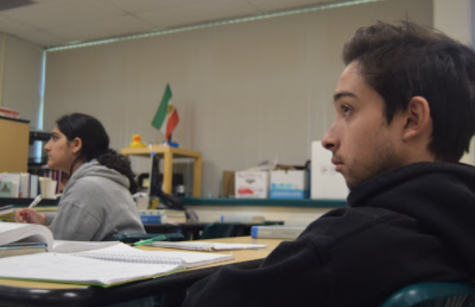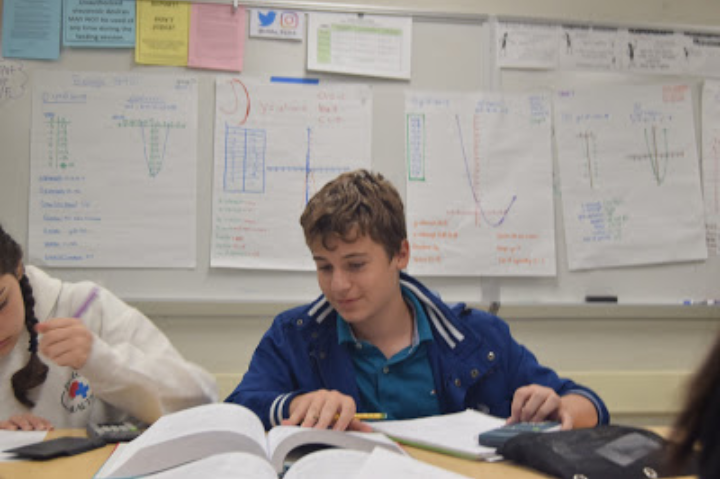CPM books have to go
Students don’t find the CPM curriculum as “beneficial”
Students in integrated math are supposed to rely on the book for their questions and practice some problems from the lesson.
In the last few years, the Glendale Unified School District decided to replace its traditional integrated math system with the current College Preparatory Math (CPM) curriculum. It was believed that students would benefit from the “learn by doing” philosophy more than a traditional lecture and notes style. However, most students, don’t agree with their goals and see the curriculum as confusing, including me.
Imagine being in an ordinary math class, in groups of four, where the teacher assigns a few problems and walks around the classroom for basically the majority of the period — only offering help when needed. Would this be a good way to learn math? Well, no, not exactly, because teachers and the books don’t teach the material very well.
Then picture yourself taking a group test with uneven groups, meaning that there might be a group with more determined and hard-working students and another with unfocused and struggling students. You are more likely going to receive a score you really don’t deserve. Tests are meant to test an individual’s skills, not a group of people.
The CPM curriculum strongly supports group work, specifically groups of four, each member with a designated role: “Resource Manager,” “Recorder/Reporter,” “Facilitator,” and “Task Manager.” These roles are designed to encourage students to learn the concepts and to collaborate with others by doing group work. This may not be a good thing as there are students who are off-task when in groups, especially if friends are put together in the same group.
In addition, teachers do not teach because of the book encouraging group work too much. All they do is walk around the classroom checking on progress, or they sit down and do other things that seem quite unimportant. While using this curriculum, it is rare for teachers to give even a short lecture for students who are genuinely confused with the material they have to work with. This leads students and parents to wonder, “Don’t teachers get paid to teach?”
Not only do the teachers rarely teach, but the book is also no help at all. CPM books have a goal to introduce students to real-life situations. These problems are well designed, but they don’t carry out their purpose if there aren’t any examples to guide the student through the steps to solving a problem similar to challenging one.

It’s rare for students to look up at a teacher and listen to them give a brief lecture on a concept being introduced.
The CPM books seem like a book made of only problems — and not a mix of examples, descriptions, and problems like other traditional, and more helpful, math books. This doesn’t seem very helpful when a student is trying to understand a new concept — on their own. Yes, there are online tools that might help, such as “Hints,” but most students would click until they found the answer.
The research that CPM uses in their favor claims that when a student is collaborating with group members on a problem that may seem completely foreign to them, it helps them form ideas on how to solve the problem which ultimately means that their critical thinking skills are being exercised. Teachers see this method as “fun and engaging,” while students see the system as confusing and a waste of time. However, even a few teachers using this book say that they are quite happy that they don’t use these teaching methods.
A poll that I have recently designed on Instagram gave some results that support my opinion. Only people who used CPM books or are still using them were able to do the poll. Around 80 people did the survey. Twenty-five percent said they like the CPM books and their methods of teaching. However, the other 75 percent said they do not like the books or their methods of teaching.
“[I do not like the CPM books] because everything is based on group work and you’re supposed to learn all the content in your group, while the teacher watches. The teacher never actually teaches anything and it’s harder to actually learn what to do,” said sophomore Jeffrey Lewis. Many other students said similar things and even expressed that students who don’t really understand the material at all will not be able to understand the material even more if the CPM system is still enforced. When they ask their teachers for guidance they are told to ask their group mates and most of the group let them copy off their answers, which last time I checked, is not an efficient way to learn math.
For many reasons, Clark should consider getting rid of the CPM system and institute a more efficient math-teaching system. To teachers, the CPM method seems brilliant and beneficial, but to the students, it only makes math worse.

Hobbies/Interests: soccer and photography
Spirit animal: fox
Places you want to travel to: Argentina, Italy, France
Favorite...

Hobbies/Interests: Stressing over AP classes but also music, swimming, fashion
Spirit animal: Dragon
Places you want to travel to: Japan, Italy...











